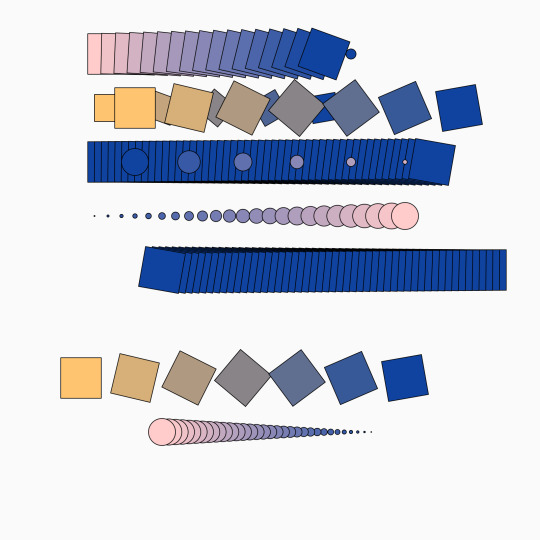#code generation
Text
When deliberating between CodeIgniter vs CakePHP for web development, consider their respective strengths and your project requirements. CodeIgniter, known for its simplicity and speed, offers a lightweight framework ideal for rapid development of small to medium-sized projects. It's praised for its straightforward configuration and extensive documentation, making it beginner-friendly. Conversely, CakePHP provides a more structured approach with built-in features like scaffolding, authentication, and ORM. It suits larger projects requiring robust security and scalability. Ultimately, the choice hinges on your project's scale, complexity, and your team's familiarity with the frameworks.
#Lightweight#Simple#Flexible#Beginner-friendly#Fast#Minimal configuration#MVC architecture#Active community#Easy to learn#Code generation#Powerful documentation#Rapid development#Convention over configuration#ORM (Object-Relational Mapping)#Batteries included#Scaffolding#Authentication and Authorization#Modular#Flexible routing#Testing support#CodeIgniter vs CakePHP
0 notes
Text
Supercharging Large Language Models with Multi-token Prediction
New Post has been published on https://thedigitalinsider.com/supercharging-large-language-models-with-multi-token-prediction/
Supercharging Large Language Models with Multi-token Prediction
Large language models (LLMs) like GPT, LLaMA, and others have taken the world by storm with their remarkable ability to understand and generate human-like text. However, despite their impressive capabilities, the standard method of training these models, known as “next-token prediction,” has some inherent limitations.
In next-token prediction, the model is trained to predict the next word in a sequence given the preceding words. While this approach has proven successful, it can lead to models that struggle with long-range dependencies and complex reasoning tasks. Moreover, the mismatch between the teacher-forcing training regime and the autoregressive generation process during inference can result in suboptimal performance.
A recent research paper by Gloeckle et al. (2024) from Meta AI introduces a novel training paradigm called “multi-token prediction” that aims to address these limitations and supercharge large language models. In this blog post, we’ll dive deep into the core concepts, technical details, and potential implications of this groundbreaking research.
Single-token Prediction: The Conventional Approach
Before delving into the details of multi-token prediction, it’s essential to understand the conventional approach that has been the workhorse of large language model training for years – single-token prediction, also known as next-token prediction.
The Next-token Prediction Paradigm
In the next-token prediction paradigm, language models are trained to predict the next word in a sequence given the preceding context. More formally, the model is tasked with maximizing the probability of the next token xt+1, given the previous tokens x1, x2, …, xt. This is typically done by minimizing the cross-entropy loss:
L = -Σt log P(xt+1 | x1, x2, …, xt)
This simple yet powerful training objective has been the foundation of many successful large language models, such as GPT (Radford et al., 2018), BERT (Devlin et al., 2019), and their variants.
Teacher Forcing and Autoregressive Generation
Next-token prediction relies on a training technique called “teacher forcing” where the model is provided with the ground truth for each future token during training. This allows the model to learn from the correct context and target sequences, facilitating more stable and efficient training.
However, during inference or generation, the model operates in an autoregressive manner, predicting one token at a time based on the previously generated tokens. This mismatch between the training regime (teacher forcing) and the inference regime (autoregressive generation) can lead to potential discrepancies and suboptimal performance, especially for longer sequences or complex reasoning tasks.
Limitations of Next-token Prediction
While next-token prediction has been remarkably successful, it also has some inherent limitations:
Short-term Focus: By only predicting the next token, the model may struggle to capture long-range dependencies and the overall structure and coherence of the text, potentially leading to inconsistencies or incoherent generations.
Local Pattern Latching: Next-token prediction models can latch onto local patterns in the training data, making it challenging to generalize to out-of-distribution scenarios or tasks that require more abstract reasoning.
Reasoning Capabilities: For tasks that involve multi-step reasoning, algorithmic thinking, or complex logical operations, next-token prediction may not provide sufficient inductive biases or representations to support such capabilities effectively.
Sample Inefficiency: Due to the local nature of next-token prediction, models may require larger training datasets to acquire the necessary knowledge and reasoning skills, leading to potential sample inefficiencies.
These limitations have motivated researchers to explore alternative training paradigms, such as multi-token prediction, which aims to address some of these shortcomings and unlock new capabilities for large language models.
By contrasting the conventional next-token prediction approach with the novel multi-token prediction technique, readers can better appreciate the motivation and potential benefits of the latter, setting the stage for a deeper exploration of this groundbreaking research.
What is Multi-token Prediction?
The key idea behind multi-token prediction is to train language models to predict multiple future tokens simultaneously, rather than just the next token. Specifically, during training, the model is tasked with predicting the next n tokens at each position in the training corpus, using n independent output heads operating on top of a shared model trunk.
For example, with a 4-token prediction setup, the model would be trained to predict the next 4 tokens at once, given the preceding context. This approach encourages the model to capture longer-range dependencies and develop a better understanding of the overall structure and coherence of the text.
A Toy Example
To better understand the concept of multi-token prediction, let’s consider a simple example. Suppose we have the following sentence:
“The quick brown fox jumps over the lazy dog.”
In the standard next-token prediction approach, the model would be trained to predict the next word given the preceding context. For instance, given the context “The quick brown fox jumps over the,” the model would be tasked with predicting the next word, “lazy.”
With multi-token prediction, however, the model would be trained to predict multiple future words at once. For example, if we set n=4, the model would be trained to predict the next 4 words simultaneously. Given the same context “The quick brown fox jumps over the,” the model would be tasked with predicting the sequence “lazy dog .” (Note the space after “dog” to indicate the end of the sentence).
By training the model to predict multiple future tokens at once, it is encouraged to capture long-range dependencies and develop a better understanding of the overall structure and coherence of the text.
Technical Details
The authors propose a simple yet effective architecture for implementing multi-token prediction. The model consists of a shared transformer trunk that produces a latent representation of the input context, followed by n independent transformer layers (output heads) that predict the respective future tokens.
During training, the forward and backward passes are carefully orchestrated to minimize the GPU memory footprint. The shared trunk computes the latent representation, and then each output head sequentially performs its forward and backward pass, accumulating gradients at the trunk level. This approach avoids materializing all logit vectors and their gradients simultaneously, reducing the peak GPU memory usage from O(nV + d) to O(V + d), where V is the vocabulary size and d is the dimension of the latent representation.
The Memory-efficient Implementation
One of the challenges in training multi-token predictors is reducing their GPU memory utilization. Since the vocabulary size (V) is typically much larger than the dimension of the latent representation (d), logit vectors become the GPU memory usage bottleneck.
To address this challenge, the authors propose a memory-efficient implementation that carefully adapts the sequence of forward and backward operations. Instead of materializing all logits and their gradients simultaneously, the implementation sequentially computes the forward and backward passes for each independent output head, accumulating gradients at the trunk level.
This approach avoids storing all logit vectors and their gradients in memory simultaneously, reducing the peak GPU memory utilization from O(nV + d) to O(V + d), where n is the number of future tokens being predicted.
Advantages of Multi-token Prediction
The research paper presents several compelling advantages of using multi-token prediction for training large language models:
Improved Sample Efficiency: By encouraging the model to predict multiple future tokens at once, multi-token prediction drives the model towards better sample efficiency. The authors demonstrate significant improvements in performance on code understanding and generation tasks, with models up to 13B parameters solving around 15% more problems on average.
Faster Inference: The additional output heads trained with multi-token prediction can be leveraged for self-speculative decoding, a variant of speculative decoding that allows for parallel token prediction. This results in up to 3x faster inference times across a wide range of batch sizes, even for large models.
Promoting Long-range Dependencies: Multi-token prediction encourages the model to capture longer-range dependencies and patterns in the data, which is particularly beneficial for tasks that require understanding and reasoning over larger contexts.
Algorithmic Reasoning: The authors present experiments on synthetic tasks that demonstrate the superiority of multi-token prediction models in developing induction heads and algorithmic reasoning capabilities, especially for smaller model sizes.
Coherence and Consistency: By training the model to predict multiple future tokens simultaneously, multi-token prediction encourages the development of coherent and consistent representations. This is particularly beneficial for tasks that require generating longer, more coherent text, such as storytelling, creative writing, or generating instructional manuals.
Improved Generalization: The authors’ experiments on synthetic tasks suggest that multi-token prediction models exhibit better generalization capabilities, especially in out-of-distribution settings. This is potentially due to the model’s ability to capture longer-range patterns and dependencies, which can help it extrapolate more effectively to unseen scenarios.
Examples and Intuitions
To provide more intuition on why multi-token prediction works so well, let’s consider a few examples:
Code Generation: In the context of code generation, predicting multiple tokens simultaneously can help the model understand and generate more complex code structures. For instance, when generating a function definition, predicting just the next token might not provide enough context for the model to generate the entire function signature correctly. However, by predicting multiple tokens at once, the model can better capture the dependencies between the function name, parameters, and return type, leading to more accurate and coherent code generation.
Natural Language Reasoning: Consider a scenario where a language model is tasked with answering a question that requires reasoning over multiple steps or pieces of information. By predicting multiple tokens simultaneously, the model can better capture the dependencies between the different components of the reasoning process, leading to more coherent and accurate responses.
Long-form Text Generation: When generating long-form text, such as stories, articles, or reports, maintaining coherence and consistency over an extended period can be challenging for language models trained with next-token prediction. Multi-token prediction encourages the model to develop representations that capture the overall structure and flow of the text, potentially leading to more coherent and consistent long-form generations.
Limitations and Future Directions
While the results presented in the paper are impressive, there are a few limitations and open questions that warrant further investigation:
Optimal Number of Tokens: The paper explores different values of n (the number of future tokens to predict) and finds that n=4 works well for many tasks. However, the optimal value of n may depend on the specific task, dataset, and model size. Developing principled methods for determining the optimal n could lead to further performance improvements.
Vocabulary Size and Tokenization: The authors note that the optimal vocabulary size and tokenization strategy for multi-token prediction models may differ from those used for next-token prediction models. Exploring this aspect could lead to better trade-offs between compressed sequence length and computational efficiency.
Auxiliary Prediction Losses: The authors suggest that their work could spur interest in developing novel auxiliary prediction losses for large language models, beyond the standard next-token prediction. Investigating alternative auxiliary losses and their combinations with multi-token prediction is an exciting research direction.
Theoretical Understanding: While the paper provides some intuitions and empirical evidence for the effectiveness of multi-token prediction, a deeper theoretical understanding of why and how this approach works so well would be valuable.
Conclusion
The research paper “Better & Faster Large Language Models via Multi-token Prediction” by Gloeckle et al. introduces a novel training paradigm that has the potential to significantly improve the performance and capabilities of large language models. By training models to predict multiple future tokens simultaneously, multi-token prediction encourages the development of long-range dependencies, algorithmic reasoning abilities, and better sample efficiency.
The technical implementation proposed by the authors is elegant and computationally efficient, making it feasible to apply this approach to large-scale language model training. Furthermore, the ability to leverage self-speculative decoding for faster inference is a significant practical advantage.
While there are still open questions and areas for further exploration, this research represents an exciting step forward in the field of large language models. As the demand for more capable and efficient language models continues to grow, multi-token prediction could become a key component in the next generation of these powerful AI systems.
#2024#ai#AI performance optimization#AI research#AI systems#amp#approach#architecture#Articles#Artificial Intelligence#AutoRegressive#BERT#Blog#Capture#challenge#code#code generation#data#datasets#details#development#direction#dog#efficiency#focus#form#Foundation#Future#generations#GPT
0 notes
Text

Integrating Social Login Seamlessly with FAB Builder: A Comprehensive Guide
In today's digital landscape, user convenience and data security are paramount concerns for developers. Social login functionality addresses these needs by allowing users to sign in to applications using their existing social media credentials, streamlining the authentication process. FAB Builder is a powerful tool that simplifies the integration of social login features into web and mobile applications. In this comprehensive guide, we'll explore how to leverage FAB Builder to seamlessly incorporate social login into your project. With intuitive interfaces and robust capabilities, FAB Builder empowers developers to enhance user experience while maintaining data security.
Understanding the Benefits of Social Login
Social login has revolutionized user interactions on the web by offering several benefits to both users and developers:
Streamlined User Experience: Users can sign in to applications using their preferred social media accounts, eliminating the need to create and manage separate login credentials for each platform.
Enhanced Conversion Rates: The simplified login process reduces user friction, leading to higher conversion rates during the onboarding process.
Data Enrichment: Social login provides access to users' profile information and social connections, enabling personalized experiences and targeted marketing efforts.
Introduction to FAB Builder
FAB Builder is an innovative code generator platform that redefines the way applications are built. With a focus on simplicity and efficiency, FAB Builder empowers users to effortlessly create front-end, back-end, and mobile apps without the need for extensive coding knowledge.
FAB Builder simplifies the integration of social login functionality into applications with its user-friendly interface and extensive provider support:
Code Example:
// Example of initializing FAB Builder SDK
FAB.init({
apiKey: 'YOUR_API_KEY',
projectID: 'YOUR_PROJECT_ID',
providers: ['google', 'facebook'], // Specify desired social login providers
onSuccess: function(user) {
// Handle successful authentication
console.log('User authenticated:', user);
},
onError: function(error) {
// Handle authentication errors
console.error('Authentication error:', error);
}
});
Key features of FAB Builder include:
User-Friendly Interface: The platform offers an intuitive panel for configuring social login providers, adjusting security settings, and generating code snippets effortlessly.
Extensive Provider Support: FAB Builder seamlessly integrates with popular social login providers such as Facebook, Google, Twitter, and more, ensuring compatibility across various platforms.
Smooth Integration: FAB Builder generates clean, optimized code snippets that can be easily incorporated into any project, irrespective of the underlying technology stack or framework.
Getting Started with FAB Builder
Begin the integration process by following these simple steps:
Create an Account: Sign up for a free account on the FAB Builder website to access its features and resources.
Start a New Project: Initiate a new project within the FAB Builder interface and specify the target platform (web or mobile).
Configure Social Login Services: Select the desired social login providers and provide the necessary API keys and return URLs.
Customize Authentication Settings: Tailor login settings, such as user information fields and permissions, to align with your project requirements.
Generate Code Snippets: Upon completing setup, FAB Builder automatically generates optimized code snippets tailored to your project specifications.
Integrating Social Login into Your Project
Incorporate social login seamlessly into your application using the generated code snippets:
Code Example:
<!-- Example of a login button triggering social login with FAB Builder -->
<button onclick="FAB.login()">Login with Social</button>
// Example of handling successful authentication event
FAB.on('login', function(user) {
// Retrieve user data and access tokens
var userData = user.profile;
var accessToken = user.token;
// Perform actions such as updating UI or making API calls
});
// Example of implementing logout functionality
function logout() {
// Perform logout action
FAB.logout();
}
Testing and Refinement
Thorough testing is essential to ensure the seamless functionality of the social login feature across various platforms and devices. Conduct comprehensive testing under different scenarios, including login, account linking, and error handling. Solicit feedback from real users to identify any usability issues or pain points. Once testing is complete, verify that the social login system is robust, secure, and delivers a seamless user experience. Monitor identity data and user interactions to evaluate the impact of social login on your app's success.
Enhancements and Customization Options with FAB Builder
Take your social login implementation to the next level with advanced features and customization options:
Single Sign-On (SSO): Simplify login across multiple sites and services with FAB Builder's SSO feature.
Updated User Profiles: Sync user profile data from social login providers to ensure the accuracy and currency of user records within your application.
Multi-Factor Authentication (MFA): Enhance account security by implementing additional authentication measures such as physical tokens or SMS verification.
Custom Branding and Styling: Customize the appearance of the social login interface to align with your app's branding and design aesthetic.
Best Practices for Security and Data Privacy
Adhere to best practices and address security concerns to safeguard user data and maintain trust:
Obtain User Consent: Clearly communicate the data access rights and privacy policies associated with social login, ensuring users provide informed consent.
Secure Data Transmission: Encrypt data transmission between the user's device and your application servers using HTTPS to mitigate the risk of eavesdropping or man-in-the-middle attacks.
Minimize Data Collection: Limit the collection of user data to what is strictly necessary for authentication and personalization purposes, reducing the potential for data breaches or privacy violations.
Regular Security Audits: Conduct periodic security audits and sensitivity reviews to identify and address potential vulnerabilities in your application's login process.
Deploying Your Social Login-Enabled Project
Deploy your application and make it accessible to users with the following steps:
Choose a Hosting Provider: Select a hosting provider capable of accommodating your project's growth, speed, and reliability requirements.
Configure Deployment Environment: Set up your deployment environment to align with your project's technologies and platforms, ensuring all necessary environment variables, API keys, and social login provider details are configured.
Package Your App: Compile and package your application code using build tools and package managers, optimizing files, minifying JavaScript, and enabling caching to enhance performance and reduce load times.
Test Deployment: Verify the functionality of the social login feature in a production environment before launching. Conduct thorough testing across various devices, browsers, and network conditions to identify and address any performance or compatibility issues.
Monitor Performance: Utilize monitoring tools and analytics platforms to monitor the performance of your deployed application, tracking metrics such as error rates, response times, and server load. Continuously optimize performance to ensure a positive user experience.
Strategies for Scaling and Improvement
Implement scaling and improvement techniques to ensure your application continues to run smoothly as it grows:
Horizontal Scaling: Increase the number of instances or nodes in your application to handle growing traffic.
Caching: Implement caching to store frequently accessed data and reduce the number of expensive database queries or API calls.
Content Delivery Networks (CDNs): Leverage CDNs to deliver static assets from edge locations closer to users.
Database Optimization: Optimize database queries, indexes, and data models to improve query performance and reduce database load.
Leveraging Social Login for User Engagement and Growth
Maximize the benefits of social login with the following strategies:
Personalized User Experience: Utilize social login data to tailor the user experience based on users' interests, preferences, and social connections.
Social Sharing and Virality: Enable social sharing features within your app to encourage users to share their experiences and achievements on social media platforms.
Social Graph Integration: Leverage social login data to access users' social networks and relationships, enabling features such as friend invites and social discovery.
Gamification and Rewards: Incorporate gamification elements and reward systems to incentivize social interactions and user participation.
Conclusion
Integrating social login with FAB Builder offers a powerful solution for enhancing user experience and driving engagement. By following the steps outlined in this guide and leveraging the capabilities of FAB Builder, you can seamlessly incorporate social login into your project and unlock its full potential. Embrace social login today to revolutionize user access and connectivity within your application.
#software development#technology#app development#app developers#low code#software#tech#mobile app development#fab builder#code generation
0 notes
Text

Geometric Shapes / 240429
3K notes
·
View notes
Text

Smol classic baby cat
#listen#i know we probably won’t see him in classic style BUT I just love him#he’s just a lil guy#classic shadow is totally kitten coded#sonic the hedgehog#shadow the hedgehog#sonic x shadow#sonic x shadow generations#sonadow generations#digital artist#my art shit#digital art#sonadow#sonic generations#sonic#sonic tag#sega
5K notes
·
View notes
Text
AI-driven Productivity in Software Development
In recent years, artificial intelligence (AI) has emerged as a powerful tool, revolutionizing various industries. One area where AI is making significant strides is software development. Traditionally, software development has relied heavily on human expertise and labor-intensive processes. However, with the integration of AI technologies, teams are now able to leverage intelligent systems to…
View On WordPress
#AI#automation#code generation#code reviews#Collaboration#debugging#documentation#future technologies#innovation#productivity#Project management#software development#testing
0 notes
Text
Code with Confidence: AI Chatbot Bard Now Assists in Programming Tasks

Hold on to your keyboards, programmers! Google's AI chatbot Bard has leveled up its skills and is now here to lend a hand in coding. Already known for its prowess in crafting poetry and planning vacations, Bard is expanding its horizons to include programming and software development tasks, such as code generation, debugging, and code explanation.
Bard is set to work with over 20 popular programming languages and will even assist in writing functions for Google Sheets. This much-awaited coding capability has been a top request from users, and Google is finally delivering on that demand.
Although Google's Bard is joining the league of rival AI chatbots like OpenAI's ChatGPT and Microsoft's Bing, which already possess coding abilities, it's essential to note that Bard is still an experimental tool. This means that it may occasionally produce incomplete or unexpected results. Therefore, users are advised to double-check Bard's responses and thoroughly test and review the code for any errors, bugs, or vulnerabilities.
Eager to try out Bard's coding skills? Currently available only in the US and UK, you can sign up to access this game-changing AI chatbot and revolutionize your programming experience!
#google#google bard#aichatbots#ai chatbot#coding#coding assistance#programming#software development#code generation#debugging#code explanation#google sheets#artificialintelligence
0 notes
Text
Maximizing ChatGPT's Potential: How We Can Use ChatGPT as a Coder
Discover the full potential of ChatGPT and how it can be used as a coder to streamline and enhance your coding experience. Read on for more information and real-life examples. #chatgpt #openai #coders #coding #how
Introduction:
ChatGPT, a language model developed by OpenAI, is a powerful tool for coding and programming. With its advanced natural language processing capabilities, it can be used to enhance the coding process and streamline workflows. In this article, we will explore the various ways in which ChatGPT can be used by coders and programmers, with real-life examples to illustrate the…

View On WordPress
#ai for coders#chatgpt#code generation#coding efficiency#coding productivity#coding tools#how to use chatgpt#open ai#programing languages
0 notes
Text

Codeigniter VS Cakephp: Which is Better for Web Development?
When deliberating between CodeIgniter vs CakePHP for web development, consider their respective strengths and your project requirements. CodeIgniter, known for its simplicity and speed, offers a lightweight framework ideal for rapid development of small to medium-sized projects. It's praised for its straightforward configuration and extensive documentation, making it beginner-friendly. Conversely, CakePHP provides a more structured approach with built-in features like scaffolding, authentication, and ORM. It suits larger projects requiring robust security and scalability. Ultimately, the choice hinges on your project's scale, complexity, and your team's familiarity with the frameworks.
#Rapid development#Convention over configuration#ORM (Object-Relational Mapping)#MVC architecture#Batteries included#Scaffolding#Authentication and Authorization#Modular#Flexible routing#Testing support#Code generation#Lightweight#Simple#Flexible#Beginner-friendly#Fast#Minimal configuration#Active community#Easy to learn#Powerful documentation
0 notes
Note
Is it just me or is your solkat giving Good Omens vibes?
specifically the way you draw them
goddamn


you're exactly right actually hshajha i did indeed have an old headcanon about this

i think it's cool how homestuck and good omens have had some overlapping fans even in the past!!
the dvkt fic mentioned is To Defy Gods and Devils by amaranthinecanicular (2013) - it was written before the tv show (2019) so i found it quite fun that the author wrote it based on their book perception of gomens
tho i did say slkt so. solkat omens!


#awesome how u made the connection!! homestuck is so us-centric i often forget my western media prefs generally lean more european 👀#ask#cybernatedbeholder#homestuck#sollux captor#karkat vantas#solkat#2024#vioart#i do like tennant's crowley a lot hehe i suppose he cld be sollux-coded. sollux snek..
955 notes
·
View notes
Text

playing dress up with my favorite dolls !! yippee!!
#accidently made the whole right side of this picture be the autistic coded characters#this drawing made me think of a beauty and the beast au with jadzia and worf and i really should get to drawing that... they'd be adorable#benjamin sisko#geordi la forge#data soong#odo#julian bashir#quark#jadzia dax#deanna troi#worf#art#star trek#deep space nine#the next generation#star trek fanart#fanart#fashion
1K notes
·
View notes
Text

WE GOTTA GO‼️
#my art#art#artwork#traditional artwork#traditional art#ranboo fanart#ranboo#fanart#charlie slimesicle fanart#charlie slimecicle#slimecicle fanart#slimecicle#generation 1#generation loss fanart#generation loss#genloss fanart#genloss#they're so brothers coded <3#they make me feel so much dread agony and sadness <333
3K notes
·
View notes
Text
not only should any autistic character who’s ever been infantilized by their fanbase kill and maim more people, but they should also fuck as nasty as possible too. as a treat
#revising a dead post that you guys liked (about autistic characters killing people)#cal.txt#autism#autistic representation#autistic characters#autism posting#fandoms#blorbo tag#jack kline#supernatural#entrapta#spop#I don’t go to SheRa and never will but I feel so deeply for how Entrapta was treated#a whole 30 some year old woman and y’all are doing That? absolutely foul#autistic coding#autistic coded character#fandom ableism#ableism in media#you cannot claim to be an ally of autistic people or disabled ppl in general while viewing us as undesirable or childlike end sentence.#either you see us as complete autonomous adult human beings or you don’t#and if your blorbo is autistic and you want them carnally do NOT be afraid to speak about it#do not let ableism win. post about how badly you wanna do things to them. it’s a free country and you’re literally correct#fandom tag#jack spn#jack supernatural#jack kline winchester#jack winchester#spn fandom#supernatural fandom#castiel
2K notes
·
View notes
Text





doodles of @skeletoninthemelonland 's Behind The Codes au springtrap and ballora bc i love them
#btc ballora is so fun to draw arggagrgahrg#still getting the hang of springtrap tho. in general#miniart#behind the codes
462 notes
·
View notes
Note
Hello! Do you have a Fanfiction or story planned for your Springdad AU?
Also have a nice day :D
I'm planning to work on... something, but it won't be in the fanfiction format since I'm not very experienced with the English language
(clears throat)

(CLEARS THROAT HARDER)

have a nice day as well :]
#I wanted to work on a smaller project like this one before moving on to bigger ones such as Behind The Codes#There's still a lot of stuff about animation and the functions of adobe animate that I'd like to know more about yknow?#not sure about this though#since I already am busy w life in general and other projects as well#springdad au#fnaf#my art
1K notes
·
View notes